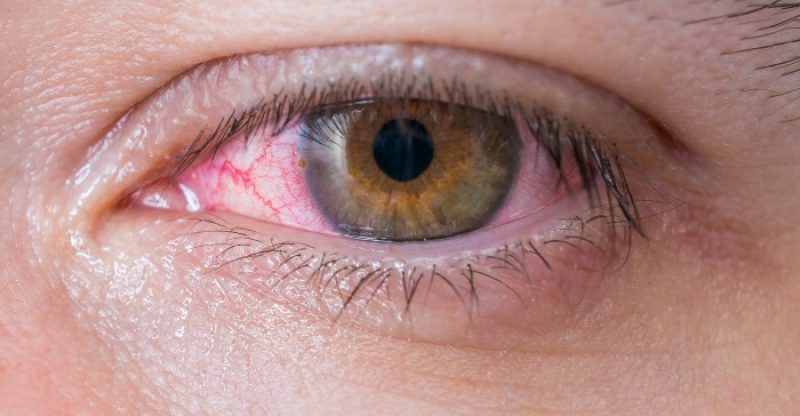Pink Eye Symptoms, Treatments and Remedies
Pink eye is an uncomfortable infection that can be inconvenient, but luckily, this infection usually clears up on its own if left untreated.
While there are several causes of pink eye or conjunctivitis, the most common is a virus, which will generally run its course in less than ten days.
Our guide helps you determine the cause of your conjunctivitis, how to prevent its spread, and how to treat the most common causes of pink eye at home.
The two leading causes of pink eye are bacteria and a virus.
The symptoms of these two illnesses are very similar, and most doctors do not test to determine which is causing conjunctivitis in most patients.
This, unfortunately, leads to many prescribing antibiotics, even when they are not warranted, which can lead to many problems, including the spread of the infection and antibiotic resistance.
The home remedies we recommend can help you tolerate the symptoms of pink eye while your immune system clears the infection.
While conventional treatments can help clear bacterial infections, other causes of conjunctivitis will heal without medical intervention in just a few days.
Understanding how to deal with the inconvenient infection can help you keep going with your daily life while your pink eye heals.
Understanding Pink Eye
Conjunctivitis, which is often referred to as pink eye, is a common eye infection that is easily transmitted from person to person.
Pink eye is known to cause itching, red eyes with thick discharge.
Most pink eye infections are caused by a virus, but bacteria or allergens cause other forms of conjunctivitis.
If left untreated, nearly all cases of conjunctivitis will clear on their own after two weeks to a month. Most infections are completely clear after just ten days.
While your eyes may still be tender or swollen and itchy, dealing with these infections is not difficult. In rare cases, pink eye can become chronic and last longer than a month (1).
Symptoms and Causes of Pink Eye
Pink eye gets its name from its most obvious symptom.
When the blood vessels in your eye become inflamed by infection, they appear pink or red.
These vessels are located in the conjunctiva membrane that covers your eyeball and lines your eyelid.
So, if you wake up in the morning with pink or red eyes, plus other conjunctivitis symptoms, you likely have an infection.
To determine the exact nature of your infection, though, a doctor will need to run some tests.
Your doctor will be unable to determine the cause of your pink eye just based on your symptoms.
Testing a sample of discharge from your eye can definitively determine what the cause of your conjunctivitis is.
Your doctor will likely want to rule out any other irritants or injuries, as well.
Bacterial Conjunctivitis
Conjunctivitis can be caused by a virus, bacteria, allergens, irritants, or a sexually transmitted disease, such as gonorrhea or chlamydia (2).
If your infection is caused by bacteria, your symptoms will usually last ten days without treatment, or up to four days with topical antibiotic treatment.
The symptoms of bacterial conjunctivitis include:
- Red or pink tinge to the whites of your eyes;
- Burning eyes;
- Watering eyes;
- Mild pain or soreness of the eyes;
- Drainage or discharge from the eye, usually yellow-green in color, that may cause crusty or sticky eyes, especially overnight;
- Swollen eyelids, which can make your eyes look droopy.
Viral Conjunctivitis
The symptoms of viral conjunctivitis are similar to those described above.
Discharge is usually watery, though.
Several viruses can cause the eye infection, including adenovirus, which is the most typical cause of viral pink eye.
Other viruses that cause pink eye include varicella zoster, poxvirus, HIV, picornavirus, and herpes simplex.
Like the bacterial variety, the viral pink eye will clear on its own, usually within ten days.
Antibiotics will not resolve the symptoms of viral conjunctivitis.
In all cases of pink eye, you remain contagious and capable of spreading the infection as long as your eyes are red (3).
Allergic Conjunctivitis
Nearly two in five people will contract allergic conjunctivitis at some point in their lives.
If your pink eye is caused by allergies, it can affect just one eye or both eyes.
Allergens enter the eye, cause irritation, and an infection develops.
Dust mites, pet dander, and pollen are common allergens that can cause allergic conjunctivitis (4).
If you are allergic to an irritant, your body produces histamine in response to the allergen.
If your eyes are histamine-intolerant, your body may produce immunoglobulin, which is an antibody.
This triggers the secretion of the mucous lining of your eyes.
Histamine also causes the dilation of the eyes’ blood vessels and can irritate the nerve endings in your eyes, resulting in red eyes and tearing.
If you have an allergic reaction, you may also be experiencing a runny nose or sneezing.
Eye Irritation
If you have an irritant, such as dirt or dust, in your eye, you may also experience conjunctivitis symptoms.
This type of pink eye generally clears in just a few days, once the irritant is flushed from the eye and the inflammation calms.
Sexually Transmitted Diseases
Two types of sexually transmitted diseases (STDs) can cause conjunctivitis from a hand-to-eye transmission.
Gonorrhea bacteria can spread from the genitals to the eyes via your hands.
This type of bacterial infection can be very serious, and lead to blindness if not treated promptly (5).
Chlamydia is also transferable from your genitals to your eyes.
If you touch infected genital secretions and then your eyes, you can easily spread the infection.
It is important to note that you can have the genital infection without exhibiting any symptoms (6).
Symptoms of STD conjunctivitis resemble those of bacterial or viral pink eye, including inflammation, tearing, discharge, crusty eyelids, and redness.
How to Treat Pink Eye at Home
Green Tea
Green tea leaves contain bioflavonoids, which can relieve the inflammation and irritation caused by pink eye infections.
To use green tea, dip a tea bag in boiling water.
Allow it to cool slightly, and place it on the infected eye.
You can also soak a washcloth in steeped green tea and use it as a warm compress on your eyes (7).
Holy Basil
Holy basil, also known as Tulsi, has been used for its medicinal properties for centuries.
Holy basil soothes and relieves inflammation, while also protecting from further damage.
Holy basil has antibacterial, antiviral, and antifungal properties.
Steep a holy basil leaf in boiling water for ten minutes.
Soak a washcloth or cotton pad in the steeped water, then use as a warm compress.
You can also use the steeped water, once cool, as an eyewash.
Turmeric
Turmeric is a natural anti-inflammatory and is also used for its antibacterial properties.
When applied topically, it can relieve the symptoms of pink eye.
To use, boil one cup of water, then add two tablespoons of turmeric powder.
Create a warm compress by soaking a washcloth or cotton pad in this solution (8).
Aloe Vera Gel
Aloe vera contains aloin and emodin, compounds with antiviral and antibacterial properties.
Aloe vera reduces inflammation and boosts immunity, which can speed the healing process.
Use aloe vera around your eye and on your eyelid.
Research indicates that aloe vera extract can be used to create eye drops that could treat conjunctivitis safely (9).
Colloidal Silver
Colloidal silver has been used to treat eye infections for decades and was frequently employed until the advent of antibiotics.
This treatment is effective against both viral and bacterial forms of conjunctivitis, and it is very useful in most cases.
Colloidal silver contains silver particles suspended in water and is less irritating to the eye than silver nitrate drops, which were previously used to treat eye infections.
Colloidal silver drops work by attracting the infected cells through electromagnetic forces, eliminating them from the eyes, and sending them into your bloodstream for elimination (10).
Drops can be applied several times a day, and just one to two drops per eye is an appropriate dose.
Neem Oil
Neem oil is popular as a soothing agent and has been used in traditional medicine in India for centuries.
As an antibacterial and anti-inflammatory, neem oil can be effective at relieving the symptoms of pink eye.
Neem oil can be used around the eyes and on the eyelids before bed to provide relief from conjunctivitis (11).
Honey
Honey has been used for centuries as an antibiotic.
It is effective at treating burns, and can also be used to treat eye infections and irritations of many kinds (12).
Honey has natural antimicrobial properties that can be used against many different types of fungi and bacteria (13).
While Manuka honey is renowned for its healing powers, you can also choose raw honey if Manuka is unavailable.
Mix one-quarter teaspoon of honey with one quarter-cup of distilled water.
Add a pinch of salt. Mix well until all particles are dissolved.
Use warm water, not boiling, to preserve the healing properties of the honey.
Use a clean eye-dropper to place one to two drops in each infected eye.
Repeat several times per day.
Herbal Infusions
Several different herbs can be used as an infusion to treat eye infections like pink eye.
Chamomile, fennel, and calendula are just a few that are effective in treating conjunctivitis.
If you are allergic to ragweed, though, do not use calendula or chamomile on or near your eyes.
It is always recommended that you use distilled water in the eyes, as any impurities in water will be removed.
To use chamomile tea, heat distilled water to just before boiling.
Add a tea bag to the water and allow to steep and cool until the water is lukewarm.
Squeeze the excess water from the tea bag, then place the bag over your closed eyelid.
Leave the bag in place for at least 15 minutes. Discard the tea bag after use.
To use calendula, add two tablespoons of dried blossoms to one-third cup distilled water that has been heated to nearly boiling.
Reduce the heat and simmer the blossoms in the water for ten minutes.
Strain the mixture and allow the water to cool to room temperature.
Soak a cotton pad or clean washcloth in the water, then squeeze the excess water out before placing over your closed eye.
Allow to sit for 15 minutes, then discard. Store the infused water in the refrigerator for continued use.
Fennel seeds can also make a useful infusion for pink eye treatment.
Add three tablespoons of crushed fennel seeds to one-third cup water.
Bring this to a boil, then simmer while covered for 15 minutes.
After removing from the heat, strain the seeds and allow the infusion to cool.
Use the same procedure as described above for calendula.
Saline Eye Wash
Using sterile saline water to flush eyes can help them heal an infection and relieve symptoms.
Saline drops are widely available in drugstores, pharmacies, and discount stores.
Saline keeps the eye lubricated, and also flushes out infected cells and mucus.
Treating Allergic Pink Eye
If allergies are causing your pink eye, removing the source of the allergens is crucial.
As long as you are exposed to the allergen, your irritation and other symptoms will continue.
Over-the-counter antihistamines can temporarily relieve your reaction to allergens, as well, but these often come with adverse side effects, including sleepiness or mental fog.
Allergy eye drops can also help.
Other Natural Treatments
To alleviate the symptoms of pink eye, you can also use several simple strategies at home.
A warm, damp washcloth makes an excellent compress to relieve pain and soothe irritation.
Be sure to use a clean washcloth and water that is not too hot.
Do not reuse the washcloth, or you could spread the infection.
If your eyes become crusty overnight, a warm washcloth can be used to clean dried mucous that causes eyes to stick together.
Ibuprofen or other NSAIDs can relieve inflammation and pain temporarily.
Artificial tears or lubricating drops can help keep your eyes moist and ease irritation.
Keeping your immune system healthy will be necessary for treating bacterial or viral conjunctivitis, so taking probiotics, eating healthy, vitamin-rich foods, and consuming plenty of antioxidants will help.
Vitamins A, C, B, and K all play a role in eye health.
Zinc supplements also boost immunity.
Preventing the Spread of Pink Eye
Because the pink eye is so contagious, it is important to learn how to prevent its spread.
You can spread viral or bacterial conjunctivitis to your other eye or to others through skin-to-skin contact or by contaminating surfaces.
Because itchy eyes is a common symptom of pink eye, you may not even realize you are touching your eyes.
Be sure you wash your hands after touching your eyes, and frequently throughout the day if you have an infection.
This will help prevent the spread of the infection, which is easily transferred from your hands to other surfaces and people.
If you do touch your eyes, use a tissue or soft cotton pad, then discard it immediately.
If you use washcloths on or near your eyes, do not reuse them without washing them in hot water.
Wash all linens that come into contact with your face, including towels, pillowcases, and other soft surfaces.
Never share products used on or near your eyes, including makeup, makeup brushes, or eye products.
Be sure to clean brushes used on infected eyes, and throw away anything that cannot be thoroughly cleaned.
If you have an infection, refrain from using contact lenses, as these can prevent infection from healing and continue to spread it.
If you wear disposable lenses, you should discard any lenses you wore while infected with bacterial or viral conjunctivitis.
Your risk of developing pink eye increases if you are exposed to the virus or bacteria that causes the disease.
Pink eye spreads easily within families and in environments like schools, daycares hospitals, and nursing homes.
If you are experiencing any symptoms, you are contagious.
Bacterial conjunctivitis is contagious until you no longer have any mucous being secreted from your eye.
If you have the bacterial pink eye and are taking antibiotics, you remain contagious for 24 hours after you start treatment.
Viral pink eye remains contagious until all symptoms are resolved.
Unless you are positive you have a bacterial pink eye, antibiotics are not effective in treating your illness or stopping the spread of the virus that causes the disease.
Because many people are given antibiotics who actually have a viral pink eye, the disease can be spread unwittingly.
When Should I See A Doctor?
If you have other symptoms not associated with pink eye, you may have another medical condition.
If you have a sensitivity to light, are experiencing poor vision, have severe headaches, or have nausea, you may have something other than the pink eye.
Your physician can help you determine if your symptoms are caused by pink eye or something else.
Some people notice floaters or flashes in their field of vision.
These are generally caused by age-related degeneration and are not usually a cause for concern.
Treating Pink Eye Conventionally
Even though the pink eye is most commonly caused by a virus, antibiotic eye drops are usually prescribed to treat the disease.
If you have viral conjunctivitis, you can treat the symptoms but will have to wait for the virus to resolve itself as there is no cure.
The use of cool or warm compresses along with saline eye drops are conventional treatments for a viral pink eye.
The natural remedies already discussed are effective at alleviating the symptoms of viral pink eye, making your pain and inflammation tolerable until your immune system is able to beat the infection.
Antibiotics are only effective in relieving symptoms in about ten percent of people, while time and patience are effective in treating nearly 50 percent of people with similar symptoms (14).
If you have allergic conjunctivitis, mast cell stabilizers and antihistamines are conventional treatments.
If you have certain medical conditions, including high blood pressure, diabetes, glaucoma, or heart disease, you may be advised not to take antihistamines.
These types of medications are known to cause dizziness, dry mouth, blurred vision, nervousness, and decreased appetite.
They also cause sleepiness in 10 to 25 percent of users, which can cause problems for many people (15).
Precautions
Pink eye is a common eye infection that is highly contagious.
It is most commonly caused by a virus, but bacteria, allergies, irritants, or an STD could also be the cause of your red, itchy eyes.
In nearly all cases, pink eye will resolve on its own within ten days, so managing your symptoms is the most effective strategy for treating pink eye.
Antibiotics are not effective for treating pink eye unless it is caused by a bacterial infection.
Viral conjunctivitis is the most common type of pink eye, and antibiotics are not effective at treating this disease.
A viral pink eye will heal in two to four weeks, and you can use natural treatments to manage your symptoms while your immune system fights the infection.
The symptoms of all kinds of pink eye are similar.
Bacterial varieties usually feature red or pink eyes that are sore, teary, burn, or have a yellow-green discharge.
You may notice your eyes are crusty in the morning, and your eyes may be swollen or droopy.
Viral pink eye usually features a watery discharge.
To prevent the spread of pink eye, wash your hands frequently and avoid touching your eyes if possible.
Do not wear contact lenses if you have an active infection, and discard any contacts that were exposed to infection, as well.
Do not share makeup or makeup brushes with others, and discard anything that came into contact with infected eyes that cannot be properly cleaned.
Wash all linens, including towels, washcloths, and pillowcases, that came into contact with your face or eyes.
Never use a washcloth on your face or eyes more than once while treating an active infection.
You may spread the infection that causes pink eye for up to two weeks after your symptoms begin to resolve, so stay diligent in your hygiene efforts, even if you start to feel better.
This type of infection is commonly spread among families or within schools, nursing homes, or daycare centers.
Children are particularly susceptible because they don’t wash their hands as frequently as needed.
Natural treatments for pink eye include aloe vera, turmeric, holy basil, green tea, neem oil, colloidal silver, herbal infusions, saline solution, and honey.
Treating the symptoms while your immune system rids your body of infection is a safe and effective method for treating pink eye.
FDA Compliance
The information on this website has not been evaluated by the Food & Drug Administration or any other medical body. We do not aim to diagnose, treat, cure or prevent any illness or disease. Information is shared for educational purposes only. You must consult your doctor before acting on any content on this website, especially if you are pregnant, nursing, taking medication, or have a medical condition.
HOW WOULD YOU RATE THIS ARTICLE?






